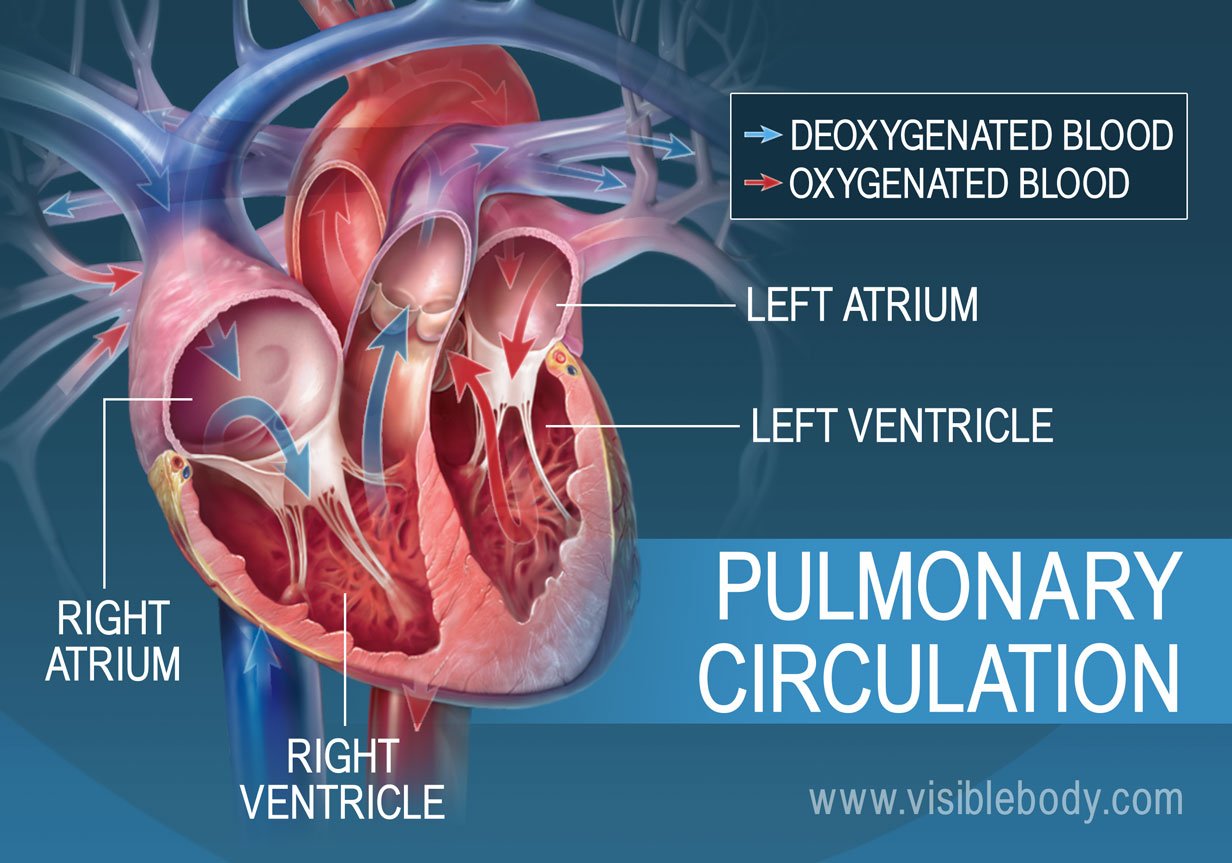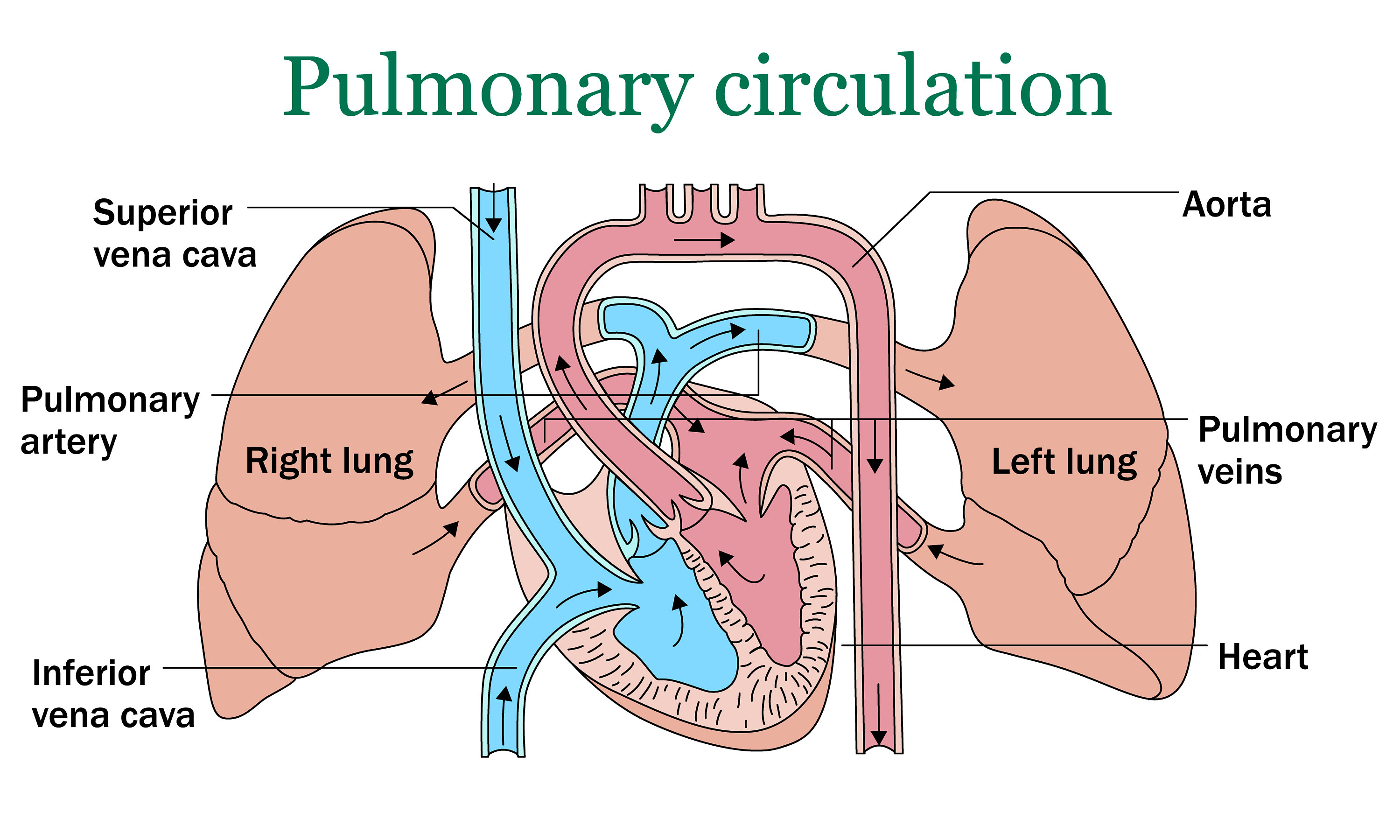
A circulação pulmonar é um dos dois circuitos da circulação sanguínea humana. É responsável por levar o sangue do coração aos pulmões, onde ele é oxigenado e retorna ao coração. A circulação pulmonar é um processo essencial para a sobrevivência, pois fornece oxigênio ao corpo para que ele funcione corretamente.
A circulação pulmonar começa no ventrículo direito do coração. O ventrículo direito bombeia o sangue venoso para a artéria pulmonar, que se divide em duas artérias pulmonares, uma para cada pulmão. As artérias pulmonares se ramificam em artérias menores e, finalmente, em capilares que circundam os alvéolos pulmonares. Nos alvéolos, ocorre a hematose, que é o processo de troca de gases entre o sangue e o ar. O oxigênio do ar passa para o sangue e o dióxido de carbono do sangue passa para o ar.
O sangue oxigenado nos capilares pulmonares é coletado pelas veias pulmonares, que se unem para formar as veias pulmonares esquerda e direita. As veias pulmonares esquerda e direita transportam o sangue oxigenado para o átrio esquerdo do coração.
A circulação pulmonar é essencial para a sobrevivência, pois fornece oxigênio ao corpo para que ele funcione corretamente. O oxigênio é necessário para que as células do corpo possam produzir energia. Sem oxigênio suficiente, as células do corpo começarão a morrer.
A circulação pulmonar também ajuda a remover o dióxido de carbono do corpo. O dióxido de carbono é um produto residual da respiração celular. Quando o dióxido de carbono se acumula no corpo, pode causar problemas de saúde, como fadiga, tontura e dores de cabeça.
Existem várias doenças que podem afetar a circulação pulmonar. Algumas das doenças mais comuns da circulação pulmonar incluem:
- Doença cardíaca congênita: Uma doença cardíaca congênita é uma condição que está presente desde o nascimento. Algumas doenças cardíacas congênitas podem afetar a circulação pulmonar.
- Doença pulmonar obstrutiva crônica (DPOC): A DPOC é um grupo de doenças pulmonares que podem dificultar a respiração. A DPOC pode afetar a circulação pulmonar.
- Insuficiência cardíaca: A insuficiência cardíaca é uma condição em que o coração não consegue bombear sangue suficiente para o corpo. A insuficiência cardíaca pode afetar a circulação pulmonar.
A circulação pulmonar é um processo essencial para a sobrevivência. É responsável por levar o sangue do coração aos pulmões, onde ele é oxigenado e retorna ao coração. A circulação pulmonar é um processo complexo que pode ser afetado por várias doenças.
WebThe pulmonary circulation is a low-pressure high-flow circuit hidden behind the thorax and therefore difficult to assess. The characteristics of the pulmonary circulation favours gas. WebPulmonary circulation can accommodate any changes in blood flow due to relative passivity and the ability to recruit unperfused vessels. Several factors such as gravity, lung. WebPulmonary circulation includes a vast network of arteries, veins, and lymphatics that function to exchange blood and other tissue fluids between the heart, the. WebPulmonary Circulation. Pulmonary circulation is the movement of blood from the heart to the lungs for oxygenation, then back to the heart again. Oxygen-depleted blood from the.

Pulmonary & Systemic Circulation | Circulatory Anatomy - Source: www.visiblebody.com

Premed HQ Pulmonary & Systemic Circulation | Premed HQ - Source: www.premedhq.com

Pulmonary circulation vector illustration on white background | Etsy - Source: www.etsy.com
What Is Pulmonary Circulation, Circulatory System | Pulmonary Circulation, 12.18 MB, 08:52, 548,441, Ninja Nerd, 2017-08-03T17:27:34.000000Z, 2, Pulmonary & Systemic Circulation | Circulatory Anatomy, www.visiblebody.com, 1232 x 863, jpeg, pulmonary circulation heart blood systemic circulatory lungs between atria flow oxygenated deoxygenated system through atrium loop right anatomy left transports, 3, what-is-pulmonary-circulation
What Is Pulmonary Circulation. WebIntroduction. Pulmonary circulation is the system of transportation that shunts de-oxygenated blood from the heart to the lungs to be re-saturated with oxygen before being dispersed into the systemic circulation. Deoxygenated blood from the lower.
Official Ninja Nerd Website: ninjanerd.org/
Ninja Nerds!
In this lecture Professor Zach Murphy will be presenting on the circulatory system and go into detail on the pulmonary blood circulation. We go describe the flow of blood through the pulmonary circuit and discuss all of the involved structures. We hope you enjoy this lecture and be sure to support us below!
Join this channel to get access to perks:
youtube.com/channel/UC6QYFutt9cluQ3uSM963_KQ/join
Support us by purchasing apparel and donating to our Patreon!
APPAREL
We are switching merchandise suppliers.
DONATE
PATREON | patreon.com/NinjaNerdScience
PAYPAL | paypal.com/paypalme/ninjanerdscience
SOCIAL MEDIA
FACEBOOK | facebook.com/NinjaNerdLectures
INSTAGRAM | instagram.com/ninjanerdlectures
TWITTER | twitter.com/ninjanerdsci
@NinjaNerdSci
DISCORD | discord.gg/3srTG4dngW
#ninjanerd #PulmonaryCirculation #CirculatorySystem
Pulmonary & Systemic Circulation | Circulatory Anatomy
What Is Pulmonary Circulation, WebPulmonary circulation includes a vast network of arteries, veins, and lymphatics that function to exchange blood and other tissue fluids between the heart, the. WebPulmonary Circulation. Pulmonary circulation is the movement of blood from the heart to the lungs for oxygenation, then back to the heart again. Oxygen-depleted blood from the.
Circulatory System | Pulmonary Circulation

Source: Youtube.com
The Simplest way to show the blood circulation || Systemic Circulation & Pulmonary Circulation

Source: Youtube.com
What is pulmonary circulation simple definition Pulmonary & Systemic Circulation | Circulatory Anatomy
What is pulmonary circulation simple definition The pulmonary trunk splits into the right and left pulmonary arteries. These arteries transport the deoxygenated blood to arterioles and capillary beds in the lungs. There, carbon dioxide is released and oxygen is absorbed. Oxygenated blood then passes from the capillary beds through venules into the pulmonary veins. What is pulmonary circulation and what is its function.
What is pulmonary circulation and what is its function
What is pulmonary circulation and what is its function What is pulmonary circulation and systemic circulation.
What is pulmonary circulation and systemic circulation Pulmonary circulation | Definition, Function, Diagram, & Facts | Britannica
What is pulmonary circulation and systemic circulation Pulmonary circulation, system of blood vessels that forms a closed circuit between the heart and the lungs, as distinguished from the systemic circulation between the heart and all other body tissues. Learn more about pulmonary circulation in this article. What is pulmonary circulation quizlet.
Pulmonary Circulation
Pulmonary circulation is the system of blood vessels forming the part of the cardiovascular system that carries oxygen-poor (deoxygenated) blood away from the heart, to the lungs, and returns oxygen-rich (oxygenated) blood from the lungs back to the heart. This description of human pulmonary , .
What is pulmonary circulation quizlet Physiology, Pulmonary Circulation - StatPearls - NCBI Bookshelf
What is pulmonary circulation quizlet Pulmonary circulation is the system of transportation that shunts de-oxygenated blood from the heart to the lungs to be re-saturated with oxygen before being dispersed into the systemic circulation. Deoxygenated blood from the lower half of the body enters the heart from the inferior vena cava while deoxygenated blood from the upper body is delivered to the heart via the superior vena cava. Both the superior vena cava and inferior vena cava empty blood into the right atrium. Blood flows through the tricuspid valve into the right ventricle. It then flows through the pulmonic valve into the pulmonary artery before being delivered to the lungs. What is pulmonary circulation.
Pulmonary And Systemic Circulation - Circulatory System - MCAT Content
The pulmonary circulation takes place from the heart to the lungs and then back to… .
What is pulmonary circulation
What is pulmonary circulation What is pulmonary circulation quizlet.
What is pulmonary circulation in anatomy Pulmonary Arteries: What They Are & What They Do
What is pulmonary circulation in anatomy Your pulmonary arteries do important work for your circulatory system. Specifically, they support the part known as your pulmonary circuit. This is the network of blood vessels responsible for sending blood back and forth between your heart and lungs. The many parts of your pulmonary circuit work together as a team to provide oxygen to your blood and remove waste products. What is pulmonary circulation class 11.
Pulmonary Circulation - an overview | ScienceDirect Topics
The pulmonary circulation is defined as extending from the pulmonic valve to the left atrium and consists of the pulmonary outflow tract, the right and left main pulmonary arteries and their lobar branches, the intrapulmonary arteries, the pulmonary arterioles, capillaries, venules, and large pulmonary veins. What is pulmonary circulation in anatomy.
Pulmonary circulation - wikidoc
Pulmonary circulation is the portion of the cardiovascular system which carries oxygen-depleted blood away from the heart, to the lungs, and returns oxygenated blood back to the heart. The term is contrasted with systemic circulation. .
.
Pulmonary circulation Definition & Meaning | Dictionary.com
Pulmonary circulation definition, the circulation of blood from the heart to the lungs for oxygenation and back to the heart. See more. .
17.2D: Systemic and Pulmonary Circulation - Medicine LibreTexts
Pulmonary circulation is the movement of blood from the heart to the lungs for oxygenation, then back to the heart again. Oxygen-depleted blood from the body leaves the systemic circulation when it enters the right atrium through the superior and inferior venae cavae. .
Physiology, Pulmonary Circulatory System - StatPearls - NCBI Bookshelf
They are designed to perform certain specific functions that are unique to the pulmonary circulation, such as ventilation and gas exchange. The pulmonary circulation receives the entirety of the cardiac output from the right heart and is a low pressure, low resistance system due to its parallel capillary circulation. The system can be divided into the following components: .
Circulatory System | Pulmonary Circulation - YouTube
Official Ninja Nerd Website: https://ninjanerd.org/Ninja Nerds!In this lecture Professor Zach Murphy will be presenting on the circulatory system and go into, .
What is pulmonary circulation class 11 Pulmonary circulation - Wikipedia
What is pulmonary circulation class 11 The pulmonary circulation is a division of the circulatory system in all vertebrates. The circuit begins with deoxygenated blood returned from the body to the right atrium of the heart where it is pumped out from the right ventricle to the lungs. In the lungs the blood is oxygenated and returned to the left atrium to complete the circuit. What is pulmonary circulation class 10th.
What is pulmonary circulation class 10th Pulmonary Circulation - an overview | ScienceDirect Topics
What is pulmonary circulation class 10th The pulmonary circulation is supplied with both sympathetic and parasympathetic innervation. In general, increased sympathetic activity leads to release of catecholamines (e.g., dopamine, norepinephrine, epinephrine, and neuropeptide Y) that cause vasoconstriction and an increase in pulmonary vascular resistance. What is pulmonary circulation class 10.
What is pulmonary circulation class 10 Pulmonary circulation Definition & Meaning - Merriam-Webster
What is pulmonary circulation class 10 "Pulmonary circulation." Merriam-Webster.com Dictionary, Merriam-Webster, https://www.merriam-webster.com/dictionary/pulmonary circulation. Accessed 25 Nov. 2023. , : the passage of oxygen-poor blood from the right side of the heart through arteries to the lungs where it picks up oxygen and is returned to the left side of the heart by veins ... : the passage of venous blood from the right atrium of the heart through the right ventricle and pulmonary arteries to the lungs where it is oxygenated and its return via the pulmonary veins to enter the left auricle and participate in the systemic circulation What is pulmonary circulation multiple select question.
What is pulmonary circulation multiple select question Circulatory Pathways | SEER Training
What is pulmonary circulation multiple select question The blood vessels of the body are functionally divided into two distinctive circuits: pulmonary circuit and systemic circuit. The pump for the pulmonary circuit, which circulates blood through the lungs, is the right ventricle. The left ventricle is the pump for the systemic circuit, which provides the blood supply for the tissue cells of the body. What is pulmonary circulation simple definition.
---
This email was sent automatically with n8n
0 Comentários